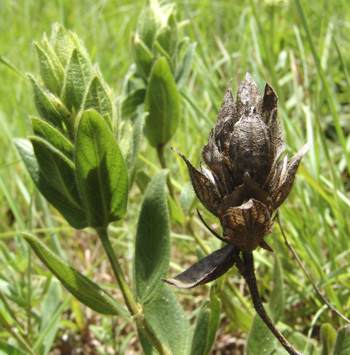Barleria ovata
Barleria ovata E.Mey. ex Nees
Family: Acanthaceae
Common names: grassland barleria (Eng.); iningizimebomvu (isiZulu)
Introduction
This barleria has pretty flowers which change colour and it resprouts from a woody rootstock after fire.

Description
Description
This is an erect or ascending, robust, perennial herb, 0.2-0.8 m in height, with several golden hairy stems arising from a woody rootstock. Leaves are opposite; blade up to 60 × 30 mm, with long soft hairs on both surfaces, often overlapping, margins toothless but hairy; leaf stalk very short, up to 2 mm long.
The inflorescence is terminal, massive, up to 90 ×50 mm. Flowers are tubular, funnel-shaped, ± 45 mm long, pale yellow in bud becoming yellow-cream-coloured, later deep purple-black, reddish to purple or shades of blue or white. Corolla tube is ± 25 mm long, cylindrical throughout, projecting beyond tips of calyx lobes, lobes half-spreading, ± 30 mm across.

Fruits are dry, compressed, splitting capsules that are smooth, shiny, ± 8.5mm .long and 4 seeded.
It flowers in summer to autumn, from November to March. As a perennial plant, it will live for a number of years and will keep re-sprouting from the woody rootstock in spring after fires.
Conservation Status
Status
According to SANBI's Red List of South African Plants (Raimondo et al. 2009), Barleria ovata is assessed as Least Concern (LC).
Distribution and habitat
Distribution description
Barleria ovata is found in the Eastern Cape, KwaZulu-Natal, Mpumalanga and Swaziland and grows in well-drained as well as damp soils in grassland in full sun, at 500-1465 m altitude. Both authors observed this plant growing in silty and loamy sand, in soil that is derived from Natal Group sandstone, whereas in Swaziland, it is found in soil that is derived from granite.
Derivation of name and historical aspects
History
The genus name Barleria is derived from the name of a Dominican monk and French botanist, Jacques Barrelier who lived during the 1600s. The species name ovata is derived from the shape of some of the leaves which are ovate. The genus consists of a group of herbs, shrubs and scramblers, some producing spines and all producing fruit in the form of explosive capsules. It consists of about 250 species of which 44 occur in South Africa.
Ecology
Ecology
Flowers of barlerias have a lot of nectar, therefore attracting bees and nectar-collecting birds. While collecting nectar these organisms inadvertently take pollen from one flower and transfer it to the stigma of the next flower. The exploding capsule in hot days ensures that the seeds are spread a few centimeters from the parent plant. it survives grassland fires by resprouting from its perennial, woody rootstock.

Uses
Use
Barleria species are exceptionally suitable to stabilise soil erosion, because of their fast growth rate and seed distribution methods. In the Zulu traditional medicine, root infusions are taken as love emetics. Root decoctions are taken or administered as enemas for the relief of the condition characterised by painful nodules under the skin.
Growing Barleria ovata
Grow
Barlerias, prefer lots of sunshine and flower profusely in full sun and not so well in shady conditions. They produce brightly coloured, showy flowers that are full of nectar that attracts bees, birds and other nectar-seeking organisms.
Barlerias in general are prone to attack from mealy bugs; to prevent this they have to be grown in humus-rich soils under suitable moisture conditions.
They can be propagated from seed or cuttings taken in early summer and rooted in coarse, sharp, river sand. However, since this is a grassland perennial plant it needs to be browsed and also requires fire from time to time. In a garden environment it eventually becomes leggy and does not continue producing flowers every year as it does in the wild. Try cutting it back each year to generate fresh spring growth.
References
- Clarke, C.B. 1912. Flora capensis , Volume 5. Sect 1. .Reeve, London.
- Hutchings, A., Scott, A.H., Lewis, G. & Cunningham, A.B. 1996. Zulu medicinal plants, an inventory. University of Natal Press, Pietermartizburg.
- Nichols, G. 2000. The indigenous garden. Farmer's Weekly . Web Printers, Johannesburg.
- Obermeyer, A.A. 1933. A revision of the South African species of Barleria . Annals of the Transvaal Museum , Vol XV. The Government Printers, Pretoria.
- Pooley, E. 1998. A field guide to wild flowers of KwaZulu-Natal and the Eastern Region. Natal Flora Publication Trust, Durban.
- Raimondo, D., Von Stad i en, L., Foden, W., Victor, J.E., Helme, N.A., Turner, R.C., Kamundi, D.A. & Manyama, P.A. (eds.). 2009. Red List of South African plants 2009. Strelitzia 25. South African National Biodiversity Institute, Pretoria.
- Retief, E. & Herman, P.P.J. 1997. Plants of the Northern Provinces of South Africa: keys and diagnostic characters. Strelitzia 6. National Botanical Institute, Pretoria.
Credits
Phakamile Zungu and Mkhipheni Ngwenya
KwaZulu-Natal Herbarium
August 2014
Plant Attributes:
Plant Type: Perennial, Shrub
SA Distribution: Eastern Cape, KwaZulu-Natal, Mpumalanga
Soil type: Sandy, Clay, Loam
Flowering season: Early Summer, Late Summer, Autumn
PH: Acid, Neutral
Flower colour: Blue, Purple, White, Cream, Yellow
Aspect: Full Sun
Gardening skill: Easy
Special Features:
Horticultural zones








Rate this article
Article well written and informative
Rate this plant
Is this an interesting plant?
Login to add your Comment
Back to topNot registered yet? Click here to register.